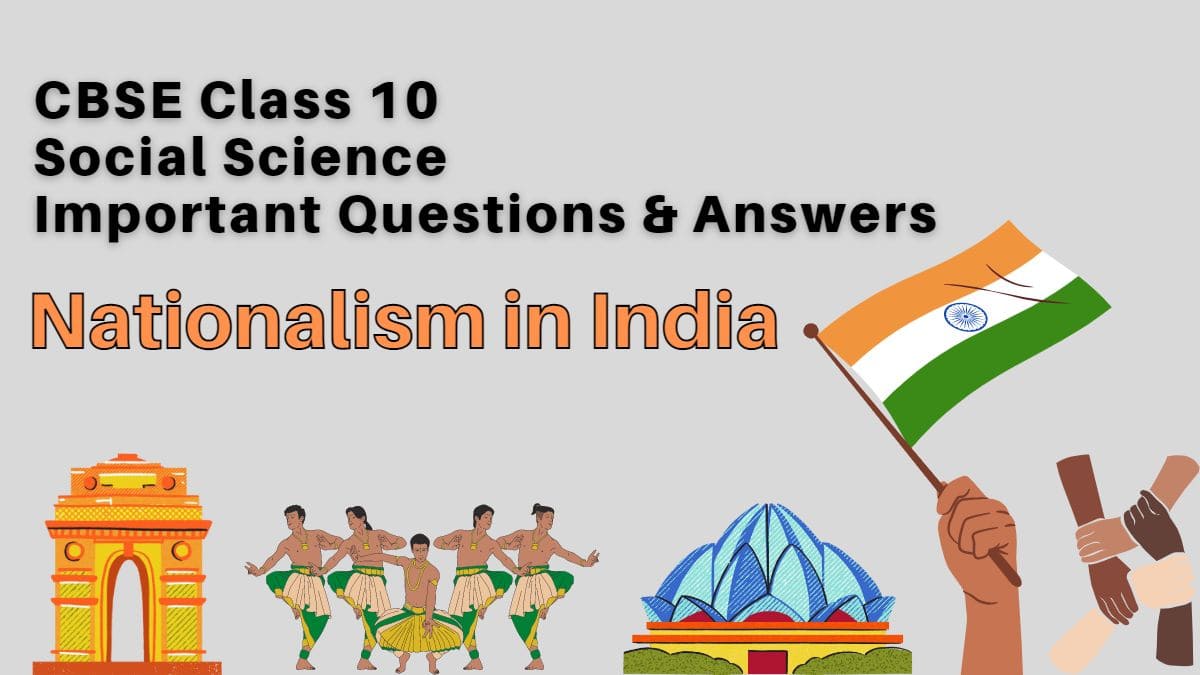CBSE CLASS 10 SST HISTORY NATIONALISM IN INDIA
Explain the idea of Satyagraha according to Gandhiji..
ANSWER: Satyagraha was a novel method of mass agitation.
The idea of Satyagraha emphasized upon the power of truth and the need to search for truth.
It suggested that if the cause was true and if the struggle was against injustice, then physical force was not necessary to fight the oppressor.
Through non-violent methods a Satyagraha could appeal the conscience of the oppressor by the power of truth, which was bound to win.
Why did Mahatma Gandhi decide to launch a nationwide Satyagraha against the proposed Rowlatt Act, 1919? Explain any three reasons.
ANSWER:
Gandhiji decided to launch a nationwide Satyagraha against the proposed Rowlatt Act, 1919, because
1) It gave enormous power to the government and no power to the leaders.
2) This law was hurriedly passed even after the united opposition by the Indians and other Indian leaders.
3) It allowed the detention of political leaders without any trial for three years.
4) It means that the British Government can arrest any Indian leader without any proof of crime.
Describe the incident of Jallianwala Bagh Massacre.
ANSWER: (a) A public meeting was organized at Jallianwala Bagh in Amritsar on 13th April, 1919 to protest against the Rowlatt Act.
(b) General Dyer ordered the military to open fire on the unarmed Indians who had gathered for the meeting.
(c) Hundreds of innocent people were killed and many others were injured.
Therefore this incident was condemned as the Jallianwala Bagh Massacre.
Why did Mahatma Gandhi decide to withdraw the ‘Non-Cooperation Movement’ in February 1922?Explain three reasons.
ANSWER: Gandhiji decided to withdraw the Non-Cooperation Movement due to various incidents of violence perpetrated by the masses, especially the Chauri Chaura incident in 1922 where the people clashed with the police, setting a police-station on fire. Gandhiji felt that the people were not yet ready for a mass struggle, and that satyagrahis needed to be properly trained for non-violent demonstrations.
“The plantation workers in Assam had their own understanding of Mahatma Gandhi and the notion of Swaraj”. Support the statement with arguments.
ANSWER: 1. The plantation workers in Assam saw freedom as the right to move freely in and out of the confined space i.e. maintaining a link with the village they had come from because under the Inland Emigration Act of 1859, the workers were not allowed to leave the plantations without permission and they were rarely given any permission.
2. When they came to know about the Non-Cooperation Movement, thousands of them defied the authorities by leaving the plantations and headed home. They believed in the power of Gandhi Raj and felt that everyone would be given land in their own villages.
3. They interpreted the term ‘swaraj’ by imagining it to be a time when all the suffering and all troubles would come to an end. They strongly identified with the movement and Gandhiji’s idea of freedom.
Why did Gandhiji launch Salt March.
ANSWER: The Second Civil Disobedience Movement was started by Gandhi on 12th March 1930 with his famous Dandi March. Together with 78 chosen followers, Gandhi walked nearly 200 miles from Sabarmati Ashram to Dandi, a village on the Gujarat sea-coast. There Gandhi and his followers made salt in violation of the salt laws. This was in response to the British introduction of taxation on salt production, deemed the sea-salt reclamation activities illegal, and the repeated use of force to stop it.
Describe the main features of the ‘Salt March’.
ANSWER: The main features of Salt March were :
1. Gandhi started the march on 12th March 1930 with 78 volunteers after Lord Irwin ignored his letter that had the demand for the abolition of the salt tax.
2. The march covered 240 miles over 24 days starting from Sabarmati to the Gujarati town of Dandi. Gandhi was accompanied by thousands of people.
3. He reached Dandi on 6th April, manufactured salt from the seawater, and violated the law.
‘The Civil Disobedience Movement was different from the Non-Cooperation Movement.’ Support the statement with examples.
ANSWER: Differences between the Non-cooperation and Civil-Disobedience Movements
Non-cooperation AND Civil-Disobedience
It was launched on September 4th, 1920 and ended on 4th February 1922. It started on March 12, 1930, through the launch of the Salt Satyagraha.
The Non-Cooperation Movement sought to bring the working of the government to a standstill by not cooperating with the administration. The Civil Disobedience Movement was an attempt at paralysing the administration by breaking some specific rules and regulations.
There was extensive scale participation of the Muslim working class in the Non-Cooperation movement. The Civil-Disobedience movement saw less participation from the Muslim community due to the policy of divide and rule by the British and the communal propaganda of the Muslim League and the Hindu Mahasabha.
The non-cooperation movement was geographically confined to certain parts of India. The civil disobedience movement saw widespread geographical coverage and mass participation in comparison to the non-cooperation movement.
The movement was called off in 1922 due to the Chauri-Chaura incident (Occurred on Feb 4th, 1922). The movement was withdrawn after the signing of the Gandhi-Irwin pact.
“Dalit participation was limited in the Civil Disobedience Movement”. Examine the statement.
ANSWER: The abstract concept of Swaraj did not move the nation's 'untouchables,' who from around the 1930's had begun to call themselves Dalit or oppressed. For long the Congress had ignored the Dalits, for fear of offending the sanatanis, the conservative high-caste Hindus. Gandhiji persuaded the upper castes to change their hearts. He himself cleaned toilets to dignify the work of the bhangi (the sweepers). He called the ‘untouchables’ Harijan, organized satyagraha to secure them entry into temples, and access to public wells, tanks, roads and schools. But many Dalit leaders were keen on a different political solution. Political empowerment, they believed, would resolve the problems of their social disabilities. They began organising themselves, demanding reserved seats in educational institutions, and a separate electorate that would choose Dalit members for legislative councils.
Explain the attitude of the Indian merchants and industrialists towards the Civil Disobedience Movement.
ANSWER: The attitude of the Indian merchants and the industrialists towards the Civil Disobedience Movement was:
1) During the 1st World War Indian merchants and industrialists had made huge profits and became powerful.
2) They wanted protection against imports of foreign goods and a Rupee Sterling foreign exchange ratio that would discourage import.
3) To organize business interest they formed the Indian Industrial and Commercial Congress (in 1920) and the Federation of Indian Chamber of Commerce and Industries - FICCI ( in 1927).
4) They gave financial assistance and refused to buy or sell imported goods.
5) Most businessmen came to see Swaraj as a time when colonial restrictions on business would no longer exist and trade and industry would flourish without constraints.
6) After the failure of the Roundtable conference, business groups were no longer uniformly enthusiastic.
7) They were apprehensive of the spread of militant activities and worried about prolonged disruption of business.
“Nationalism spreads when people begin to believe that they are all part of the same nation.” Justify the statement.
ANSWER:The spreading of nationalism took place due to following factors
(i) United Struggle Different religious groups and communities unitedly struggled against the British rule.
(ii) Cultural Processes Unity spread through various cultural processes like history, folklore, songs and symbols that helped in spread of nationalism.
(iii) Common Identity The painting of‘Bharat Mata was commonly identified as motherland and affected the people equally.
(iv) Revival of India Folklore Reviving the folklore through folk songs, legends helped in promoting traditional culture and restore a sense of pride in the past history and culture.
(v) Role of the Leaders Leaders like’ Mahatma Gandhi, Jawaharlal Nehru aroused the feelings of nationalism through their motivational speeches and political activities.
Thus, it can be concluded that nationalism spread, when people began to believe that they were all part of the same nation.
What is Martial Law? What role did it play in Jallianwala Bagh incident?
ANSWER: General Dyer passed an Act on April 13, 1919, named the martial law stating that no more than 2 people can form a group and meet at a place. This act was enacted to prevent any form of a mobilised protest against the ruling authorities. This coincided with the Sikh festival of Baisakhi, where they had gathered at jallianwala Bagh for celebrations, upon which General Dyer open fired on people present there.
Who launched the Khilafat Movement?
ANSWER: The Khilafat Movement was launched by Muhammad Ali and Shaukat Ali. The movement was aimed to unite the Muslim community under the umbrella of a unified national movement.
What was Simon Commission?
ANSWER:
The Indian Statutory Commission also known as Simon Commison', was a group of seven Members of Parliament under the chairmanship of Sir John Simon (later, 1st Viscount Simon). The commission arrived in British India in 1928 to study constitutional reform in Britain's largest and most important possession.
Why was Poona Pact signed?
ANSWER: The Poona Pact refers to an agreement between Dr. B. R Ambedkar and Mahatma Gandhi signed on 24 September 1932. When the British government conceded Dr. Ambedkar's demand, Gandhiji began a fast unto death. He believed that separate electorates for Dalits would slow down the process of their integration into society. Dr. Ambedkar ultimately accepted Gandhiji's position and the result was the Poona Pact of September 1932.
Who designed the Swaraj flag? Which colours were included in it?
ANSWER: By 1921, Mahatma Gandhi designed the Swaraj flag. This was a tricolour flag and had a spinning wheel in the centre of a red, green and white banner.
Read the given text and answer the following questions:
In the countryside, rich peasant communities – like the Patidars of Gujarat and the Jats of Uttar Pradesh –were active in the movement. Being producers of commercial crops, they were very hard hit by the trade depression and falling prices. As their cash income disappeared, they found it impossible to pay the government’s revenue demand. And the refusal of the government to reduce the revenue demand led to widespread resentment. These rich peasants became enthusiastic supporters of the Civil Disobedience Movement, organising their communities, and at times forcing reluctant members, to participate in the boycott programmes. For them the fight for swaraj was a struggle against high revenues. But they were deeply disappointed when the movement was called off in 1931 without the revenue rates being revised. So when the movement was restarted in 1932, many of them refused to participate.The poorer peasantry were not just interested in the lowering of the revenue demand. Many of them were small tenants cultivating land they had rented from landlords. As the Depression continued and cash incomes dwindled, the small tenants found it difficult to pay their rent. They wanted the unpaid rent to the landlord to be remitted. They joined a variety of radical movements, often led by Socialists and Communists. Apprehensive of raising issues that might upset the rich peasants and landlords, the Congress was unwilling to support ‘no rent’ campaigns in most places. So the relationship between the poor peasants and the Congress remained uncertain.
a) Name two rich peasant communities who were active in the movement?
rich peasant communities like the Patidars of Gujarat and the Jats of Uttar Pradesh were active in the movement.
b) Why did rich peasants joined the Civil Disobedience Movement?
In the countryside, rich peasant communities, like the Patidars of Gujarat and the Jats of Uttar Pradesh, were active in the Civil Disobedience movement. Being producers of commercial crops, they were very hard hit by the trade depression and falling prices. As their cash income disappeared, they found it impossible to pay the governments revenue demand. The refusal of the Government to reduce the revenue demand led them to participate in the Civil Disobedience movement.
c) Why the relationship between the poor peasants and the Congress remained uncertain?









0 Comments